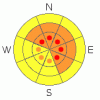|
Now here's where conditions become less predictable-
We've been talking at length about the now buried January surface hoar, which sits under the infamous MLK rain crust. It's a strange combination, one that we're not used to dealing with. The fact of the matter is that it's surprising very experienced riders. Why?
Well, part of it is that the snow feels so good under our machines. It's stiff and supportable and now has a fresh powder topping. Sounds like great riding conditions, but that doesn't tell the whole story. Remember- we’ve got to not only think about the snow we’re riding in, but also the snow we’re riding on. That supportable snow is actually a stiff and very well connected three foot deep (and growing) slab. Unfortunately, the patent is still pending on our “Avalanche Detection Goggles” and there are weak points in the slab that we just can't see unless we dig into the snow and investigate the layering. Problem is, as soon as we ride over one of those weak points, the slab pulls out and we're off on a ride that may very well be unsurvivable.
It's misleading because you can ride a number of slopes without incident and then Wham, the next one avalanches. That's the challenging characteristic of what we’re dealing with right now and the terrain doesn’t need to be big and gnarly either. As a matter of fact, a number of recent avalanches have been triggered on very low angle slopes. One recurring theme with the human triggered avalanches has been mid slope breakovers, just a few degrees steeper than the rest of the slope. We don’t feel it, but the avalanche is all over it.
Every significant storm has sparked a natural avalanche cycle with the surface hoar as the guilty layer. The last round of avalanches averaged 3' in depth. We just added another foot of snow with nuking winds, which should be more than enough weight to initiate a natural avalanche cycle, but this time the depths will be pushing 5'…. Yikes!
So, what can we do as riders to have fun, but still get home in one piece at the end of the day? When our buddies are riding, we can stay well out of the avalanche runouts, watching our partners safely from a distance. Be aware of what's above you, as the current situation promotes remote triggering, meaning you can trigger avalanches far above you from great distances. Be heads up! We can use the terrain to our advantage too, but right now we've got to tone down our terrain choices. We can safely ride very low angle slopes at mid and lower elevations. We can work ridgelines to get up high, but we've got to be careful not to get sucked into the open faces where the avalanche danger is deceptively elevated. I know this kind of riding isn't nearly as thrilling as ripping up steep tree shots and open bowls, but right now, the more aggressive riding is a pure roll of the dice, and there's a reason that the house wins more often than not. |



